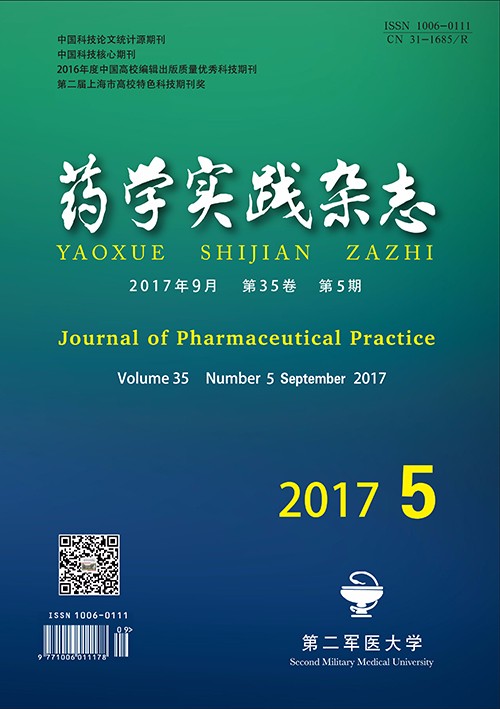SUN Guoquan, SHU Lixin, WANG Xiaojuan, CHEN Shengxin, YANG Zhangwei, LI Jiewei. Study on the use of antimicrobial agents in hospitalized trauma patients based on medical big data[J]. Journal of Pharmaceutical Practice and Service, 2017, 35(5): 466-471. doi: 10.3969/j.issn.1006-0111.2017.05.021
| Citation:
|
SUN Guoquan, SHU Lixin, WANG Xiaojuan, CHEN Shengxin, YANG Zhangwei, LI Jiewei. Study on the use of antimicrobial agents in hospitalized trauma patients based on medical big data[J]. Journal of Pharmaceutical Practice and Service, 2017, 35(5): 466-471. doi: 10.3969/j.issn.1006-0111.2017.05.021
|
Study on the use of antimicrobial agents in hospitalized trauma patients based on medical big data
- 1.
Institute of Drug and Instrument Control in Xinjiang Military Command of PLA, Urumqi 830069, China
- 2.
Department of Pharmacy Administration, School of Pharmacy, Second Military Medical University, Shanghai 200433, China
- 3.
Department of Pharmacy, Changhai Hospital affiliated to Second Military Medical University, Shanghai 200433, China
- Received Date: 2015-12-08
- Rev Recd Date:
2017-08-07
-
Abstract
Objective To investigate the relationship between the trauma severity and the usage of antibacterial drugs and to provide reference for standard protocol of proper antibiotic use in wound care. Methods ICD-10 and AIS were used to set up the relationship and to analyze the use of antibiotics in patients with different trauma score. Results 25 035 trauma patients were enrolled in this study. Those patients were divided into five groups according to the AIS score with least severe as group 1 to most severe as group 5. The patient percentage in group 1 to 5 was 21.92%,67.73%,8.86%,0.97% and 0.52% respectively. The five most frequently used antibiotic classes are second generation cephalosporins,third generation cephalosporins,first generation cephalosporins,fluoroquinolones and penicillin/beta lactamase inhibitor combination, accounted for 29.69%,22.57%,20.33%,4.66% and 4.47% of total DDDs of antibacterial drugs. Individually, the top 10 antibiotics are cefuroxime (12.21%), cefazolin (8.31%), ceftriaxone (7.74%), cefathiamidine (7.34%), cefotiam (4.87%), ceftazidime (3.68%), amoxicillin/clavulanic acid (3.63%), levofloxacin (3.59%), cefoxitin (3.56%), flucloxacillin (3.52%); gentamicin (2.27%), ornidazole (2.00%) and cefoperazone/tazobactam (1.44%) were used most in their categories respectively. The variety and quantity of antibacterial drugs used for different trauma patients were different. Conclusion The trauma score based on ICD-AIS can reflect the severity of trauma. The use of antibiotics in patients with different trauma score can provide reference for the clinical applications of antibiotics in wound care.
-
References
|
[1]
|
Tribble DR,Conger NG,Fraser S,et al.Infection-associated clinical outcomes in hospitalized medical evacuees after traumatic injury: trauma infectious disease outcome study[J].J Trauma,2011,71 (1S):S33-42. |
|
[2]
|
宋 方, 何晓静, 菅凌燕.美国控制细菌耐药有关政策及对我国的启示[J].中国临床药理学杂志,2014,(8):736-738. |
|
[3]
|
Zhang QQ, Ying GG,et al. Comprehensive evaluation of antibiotics emission and fate in the river basins of China: Source analysis, multimedia modeling, and linkage to bacterial resistance[J]. Environ Sci Technol,2015,49(11):6772-6782. |
|
[4]
|
卫生部.卫办综发[2011] 166号,卫生部办公厅关于印发《疾病分类与代码(修订版)》的通知[S]. 2011-12-30. |
|
[5]
|
Rutledge R,Osier T.The ICD-9-Based illness severity score:a new model that outperforms both DRG and APR-DRG as predictors of survival and resource utilization[J].J Trauma,1998,45:791-799. |
|
[6]
|
Committee on Injury Scaling. The Abbreviated Injury Scale,1998 revision(AIS-98)[S].Des Plaines(IL): Association for the Advancement of Automotive Medicine, 1998. |
|
[7]
|
Baker SP, O'Neill B, Haddon W Jr, et al. The injury severity score: a method for describing patients with multiple injuries and evaluating emergency care[J]. J Trauma,1974,14:187-196. |
|
[8]
|
Linn S. The injury severity score importance and uses[J]. Ann Epidemiol,1995,5:440. |
|
[9]
|
MacKenzie EJ,Steinwachs DM,Shankar B.Classifying trauma severity based on hospital discharge diagnoses.Validation of all ICD-9 CM to AIS-85 conversion table[J].Med Care,1989,27:412-422. |
|
[10]
|
薛富波,王玉琨,徐勇勇.创伤国际疾病分类编码向AIS分值转换规则的研究[J].中华创伤杂志,2003,19:385-388. |
|
[11]
|
陈维庭.正确掌握和使用创伤评分法(AIS-ISS) [J].创伤外科杂志,2001,2 (2):81-82. |
|
[12]
|
卫生部.国卫办医发[2015]43号,关于印发抗菌药物临床应用指导原则(2015年版)的通知[S].2015-07-24. |
-
-
Proportional views

-







 DownLoad:
DownLoad: